EAL Guidance for Schools and Leaders
EAL guidance for schools and leaders on provision, funding, working with parents and learners.
Explore the guidance

Useful resources for schools welcoming newly arrived learners who speak English as an Additional Language (EAL).

Key principles for schools working with new arrivals.

Refugee and asylum seeking children and young people in England, like other new arrivals, are a very diverse group.









